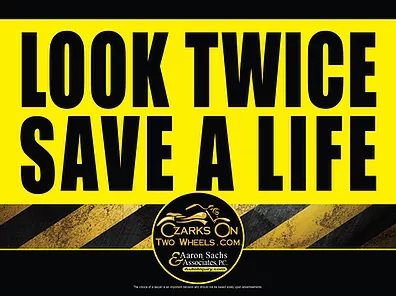LOOK TWICE, SAVE A LIFE
12 Do's and Dont's After a Motorcycle Accident
DO
CALL 911 if there are injuries. Call the Local Police if there only seems to be property damage no matter how minor.
COLLECT INFO including names, contact and insurance information from any others involved in the accident.
TAKE PICTURES of the scene, including the license plates of all vehicles involved. With permission, photograph the other parties’ insurance documents.
TALK TO WITNESSES, get their names and contact information.
KEEP THE BIKE “AS IS” until damages are determined.
CALL Aaron Sachs & Associates at 1-888-777-2886.
DON'T
DO NOT LEAVE THE SCENE of the accident before police arrive.
DO NOT LEAVE YOUR MOTORCYCLE unattended.
DO NOT APOLOGIZE, assume responsibility or discuss issues of fault.
DO NOT ASSUME you’re okay. Some consequences of injuries surface weeks or months after a wreck.
DO NOT TALK TO THE OTHER GUY’S INSURANCE ADJUSTOR
DO NOT SIGN OR AGREE TO ANYTHING without first talking to an attorney. You can reach Aaron Sachs & Associates at
1-888-777-2886.
FREE

Bumper Sticker

Yard Sign
The ABC's of Motorcycle Safety
A – Always wear a helmet: Helmets protect your head in case of a crash.
B – Be visible: Wear bright clothing and use lights to make sure other drivers can see you.
C – Control your speed: Stay within the speed limit and ride at a safe speed for the conditions.
D – Don’t drink and ride: Alcohol impairs your ability to ride safely.
E – Educate yourself: Take a motorcycle safety course to learn how to ride properly.
F – Follow the rules of the road: Obey traffic laws and be aware of your surroundings.
G – Gear up: Wear protective gear like gloves, jackets, pants, and boots to reduce the risk of injury in a crash.
H – Have a maintenance routine: Keep your motorcycle in good condition by regularly checking tires, brakes, lights, and other essential parts.
I – Increase your skills: Practice riding in different conditions and environments to improve your abilities.
J – Join a riding group: Riding with others can provide support and help you learn from more experienced riders.
K – Keep your distance: Maintain a safe following distance from other vehicles to give yourself time to react to unexpected situations.
L – Look ahead: Always scan the road ahead and anticipate potential hazards.
M – Make yourself heard: Use your horn or signals to alert other drivers of your presence.
N – Never assume: Always assume that other drivers may not see you and be prepared to react accordingly.
O – Obey traffic signals: Respect traffic signals and signs to avoid accidents.
P – Plan your route: Know where you’re going and plan your route in advance to avoid getting lost or ending up in unfamiliar areas.
Q – Quick reflexes: Practice emergency maneuvers like swerving and braking to improve your ability to react quickly in dangerous situations.
R – Ride defensively: Be aware of potential hazards and be prepared to take evasive action if necessary.
S – Stay focused: Keep your attention on the road and avoid distractions like texting or talking on the phone while riding.
T – Take breaks: Long rides can be tiring, so take regular breaks to rest and rehydrate.
U – Use your mirrors: Check your mirrors frequently to stay aware of what’s happening behind you.
V – Visibility is key: Make sure your headlights, taillights, and turn signals are working properly so other drivers can see you.
W – Weather awareness: Be aware of weather conditions and adjust your riding accordingly.
X – X-tra caution at intersections: Intersections are where most accidents happen, so approach them with extra caution.
Y – Yield to safety: When in doubt, yield to other vehicles or pedestrians to avoid potential collisions.
Z – Zero tolerance for reckless behavior: Don’t take unnecessary risks or engage in reckless behavior while riding.